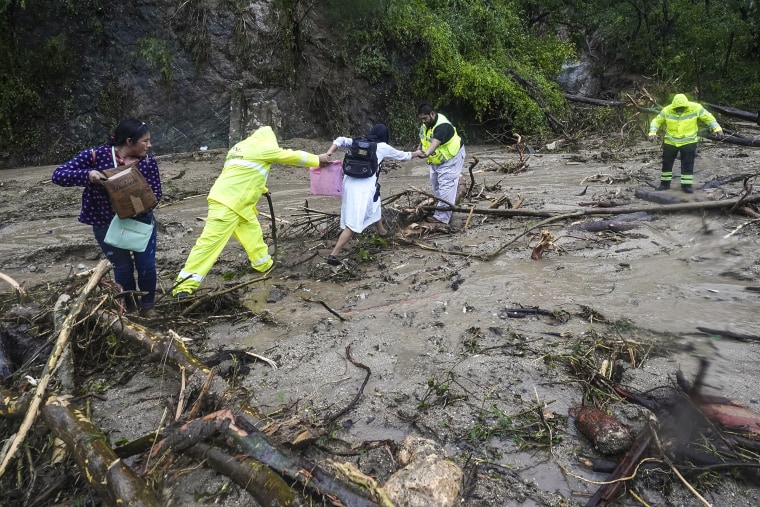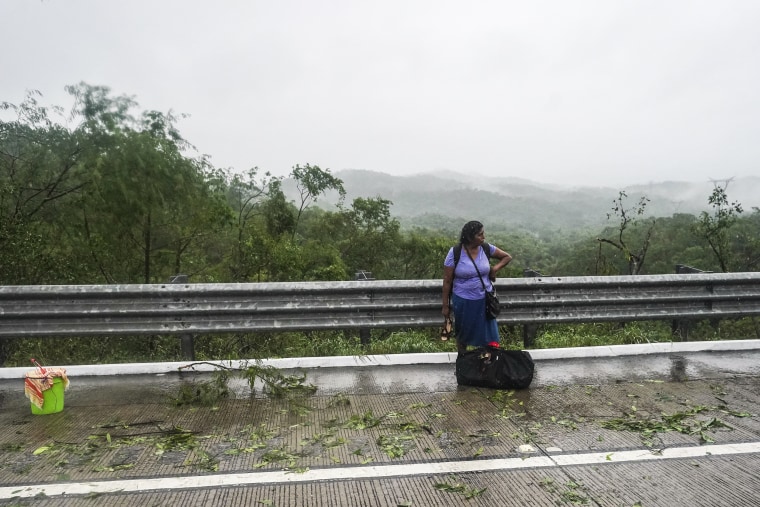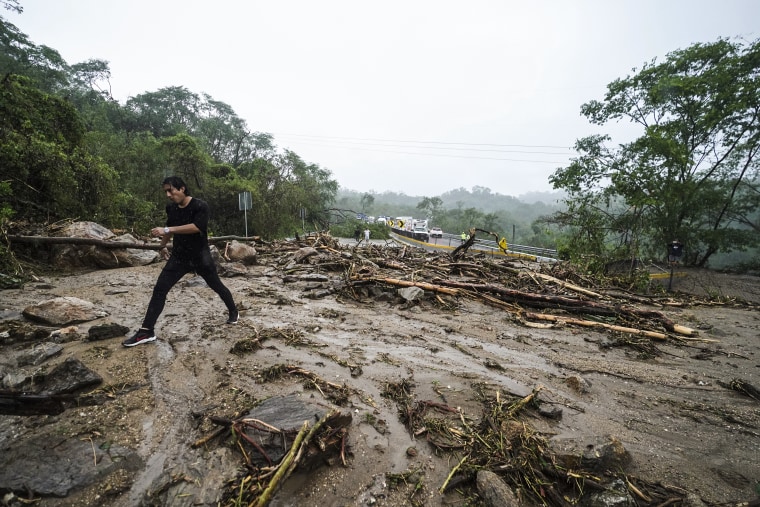What to know about Hurricane Otis
- Hurricane Otis made landfall as a 165-mph Category 5 hurricane, the strongest to ever hit Mexico's Pacific coast and the eastern Pacific.
- Otis slammed into the tourist destination of Acapulco and all communication from the region is down, Mexican President Andrés Manuel López Obrador said.
- The storm intensified by 80 mph in 12 hours, which is the fastest rapid intensification in the eastern Northern Pacific in the satellite era since 1966.
- The explosive intensification is due to warmer waters in the Pacific, with a growing body of research linking this increase to human-caused climate change.
- As of 2 p.m. ET, the storm was downgraded to a tropical storm with winds of 60 mph.
Ports remain closed in Acapulco following Otis
Mexico’s national civil protection coordination agency said ports in the state of Guerrero are still closed after Hurricane Otis.
Ports in Acapulco are not allowing the entrance of both large and small boats. In Puerto Marqués, ports are closed only for small boats.
Mexico's security cabinet moves to Acapulco to aid residents affected by Otis
Mexican President Andrés Manuel López Obrador instructed the heads of Mexico’s security cabinet to move to the port of Guerrero to accelerate care and assistance to the population affected by Hurricane Otis, a government news release said this afternoon.
The heads of security were also instructed to carry out damage assessments to help determine whether additional measures are necessary for the region's recovery.
Initial reports indicate that Guerrero has endured significant destruction, including damage to communication lines, which makes it difficult to obtain accurate information. López Obrador said the Secretariat of Infrastructure, Communications and Transportation is working to restore connectivity as soon as possible.
Mexico braces for potential humanitarian disaster in the wake of Otis
Mexico is beginning to assess the damage from Hurricane Otis, which made landfall as a Category 5 hurricane near Acapulco. Bill Karins reports on the impact that has caused a widespread outage and the potential for a humanitarian disaster.
Heavy rainfall and flash flooding hits southern Mexico as Otis is downgraded to tropical storm
As Otis — now a tropical storm — moves inland, heavy rainfall and flash flooding continues over portions of southern Mexico, the U.S. National Hurricane Center said in its latest advisory.
Maximum sustained winds have decreased to 60 mph. A tropical storm warning is still in effect for Punta Maldonado westward to Acapulco.
Quake detected in hurricane-ravaged state of Guerrero
A 4.4-magnitude earthquake was detected in the resort city of Zihuatanejo, northwest of Acapulco, in the Mexican state of Guerrero just hours after being hit by Hurricane Otis.
The quake comes as the region reels from one of the strongest hurricanes to ever hit Mexico.
Mexico's national civil protection coordination agency said it has been in touch with state and municipal personnel in the area "to carry out a preliminary evaluation of the area."
The earthquake struck the hurricane-ravaged region as much of the seismic sensor network used to detect quakes was offline due to Otis' destruction.
“This situation means that if an earthquake occurs in these areas, we will not be able to alert the population,” SkyAlert, the service used to provide early earthquake warnings, previously said in a news release.
“The magnitude of the damage caused by the hurricane has left our infrastructure temporarily inoperative, and at this time we cannot determine when service will be completely restored in Guerrero.”
Acapulco airport inaccessible and highway blocked by landslide after Otis destruction
Transporting aid to Acapulco is a priority for Mexican authorities following the devastation of Hurricane Otis, but the Mexican military said destruction caused by the storm has left it unable to access the airport as well as major roads into the city.
Heavy rains from Otis triggered a landslide that blocked a main Acapulco highway, causing "a total closure to traffic," according to the Secretariat of Infrastructure, Communications and Transportation in the state of Guerrero. "There is no alternate route. Take precautions."



Otis knocks seismic sensors offline, leaving Mexico vulnerable to earthquakes
Much of the seismic sensor network used in Mexico to detect earthquakes is offline due to the destructive effects of Hurricane Otis in the state of Guerrero, according to a news release from SkyAlert, the service used to provide early earthquake warnings.
"This situation means that if an earthquake occurs in these areas, we will not be able to alert the population," SkyAlert said. “The magnitude of the damage caused by the hurricane has left our infrastructure temporarily inoperative, and at this time we cannot determine when service will be completely restored in Guerrero.”
Technical teams are monitoring the situation and are expected to "carry out the necessary corrective maintenance as soon as conditions allow," according to SkyAlert.
Mexico is particularly vulnerable to earthquakes because it is uniquely situated near five tectonic plates: Cocos, North American, Pacific, Caribbean and Rivera.
How Hurricane Otis went from a tropical storm to a Category 5 in 24 hours
Hurricane Otis hit Mexico as one of the strongest storms in the country’s history, knocking out power and internet service with 165 mph winds. NBC News’ Bill Karins describes how the storm developed in 24 hours and how the hurricane could cause extreme damage.
More than 500,000 customers in Mexico lost electricity during Otis
Hurricane Otis left more than 500,000 power customers in the state of Guerrero without electricity, according to Mexico’s Federal Electricity Commission.
The commission said it was able to remotely restore power to about 40% of those customers, adding that “as soon as conditions allow, personnel will go to work on site.”
A team of hundreds of electrical workers, cranes, emergency vehicles, generators and a helicopter have been enlisted to restore power, according to the commission.
Hurricane warning downgraded to tropical storm warning, but flooding risk persists
As Hurricane Otis continues to move farther inland, the government of Mexico discontinued the hurricane warning west of Acapulco, the U.S. National Hurricane Center said in its latest advisory. The hurricane warning from Acapulco to the town of Punta Maldonado was also downgraded to a tropical storm warning. The storm surge across Mexico’s southern coast is gradually subsiding.
Otis' maximum sustained winds have decreased to 80 mph, and continued weakening is expected as the storm moves over the mountains of Mexico, the NHC said. Otis is expected to dissipate over southern Mexico tonight.
The storm is still expected to produce additional rainfall totaling 4-6 inches across Guerrero and the western coastal sections of Oaxaca, which may produce flash and urban flooding.
Officials race to restore phone lines in state of Guerrero, including Acapulco
Evelyn Salgado Pineda, governor of the state of Guerrero, said authorities “are already coordinating to restore telephone lines as soon as possible” after all communications collapsed in the area hit by Hurricane Otis.
Her office has remained in touch with the mayors of hard-hit cities such as Acapulco as well as the regions of Costa Chica and Costa Grande, “where attention has already been provided to those who require it,” Salgado Pineda said on X.
Federal, state and municipal officials in Mexico have already met to start assessing hurricane damage, Salgado Pineda said, adding she will remain in Guerrero “attentive to the needs of our people.”
Video shows heavy damage after Hurricane Otis makes landfall in Mexico
X user @ClintonHaVi documented the hurricane's impact on the Princess Mundo Imperial hotel in Acapulco, showing damaged infrastructure and flooded hallways.
Authorities in Acapulco have closed the city’s port, home to around 300 fishing boats. The city is known as a major tourist destination and beach resort town with a population of around 850,000 people, according to the Mexican government.
All communication around Acapulco is down, Mexico's president says
All communication in the areas affected by Hurricane Otis has collapsed, Mexican President Andrés Manuel López Obrador said in a news conference Wednesday morning.
López Obrador said they are looking to start repairs as soon as it is possible.
Authorities in Mexico still don't have any information about deaths caused by the hurricane, "but remember, we have no communication yet," López Obrador said.
He added that material damages are accumulating, but it's too early to assess the extent of that damage.
While Otis was downgraded to a Category 2 hurricane, López Obrador said they expect rain all day in the state of Guerrero, where it made landfall overnight.
López Obrador said the biggest concern today are the people living from Acapulco to Zihuatanejo.
3 million people under flood watch from central Oklahoma to Texas
Around 3 million people in the U.S. are under a flood watch due to Otis, stretching from central Oklahoma to Del Rio, Texas. Heavy hourly rainfall rates across the region of 1 to 3 inches could cause flash flooding in already oversaturated soil.
"The moisture from [Otis] is now starting to stream up from Mexico and get caught up into the jet stream and brought up into Texas," NBC News weather anchor Al Roker said.
More rapidly intensifying hurricanes in a warming world
Otis rapidly intensified by 115 mph in 24 hours and 80 mph in 12 hours.
Rapidly intensifying hurricanes (defined as strengthening 35 mph in 24 hours) are becoming more frequent, and there is a growing body of research linking this increase to human-caused climate change.
Human activity has led to warming not only in the atmosphere, but also in the oceans, and the oceans have absorbed around 90% of the warming that has occurred in recent decades due to increased greenhouse gas emissions.
Warm water is the main fuel for hurricanes, and so warmer oceans fuel stronger hurricanes. As oceans continue to warm, this increases the probability of tropical cyclones undergoing rapid intensification.
Otis intensified when it tracked over Pacific sea surface temperatures that were nearly 90 degrees Fahrenheit. (That is approximately 2-4 degrees Fahrenheit above average.)
As seen with Otis, rapid intensification can be challenging to forecast. This is why an explosively intensifying hurricane on approach to landfall is a nightmare scenario and contributes to the human and financial toll of these types of hurricanes especially when slamming into a populated area such as Acapulco.
According to Climate Central, the six most costly hurricanes since 1980 all rapidly intensified 45-80 mph in the span of 24 hours.
Video shows Hurricane Otis lashing Acapulco
Video posted to X early this morning by @ClintonHaVi shows palm trees violently swaying in Acapulco as heavy rain and powerful winds from Otis slam the region.
Stats on Otis' rapid intensification
In just 24 hours, Otis rapidly intensified from a tropical storm with 50 mph winds to a Category 5 hurricane with winds of 165 mph.
That is a 115 mph increase, and the definition for rapid intensification for a storm is just 35 mph within that time span. The storm intensified wind speeds by 80 mph in just 12 hours.
Guerrero state government prepares shelters in anticipation of storm surge
The Guerrero state government said it was preparing 396 shelters in anticipation of families being driven from their homes by wind damage or surging waters.
"If your house is safe: Don’t go out at all," Acapulco Mayor Abelina López Rodríguez warned on Facebook, sharing the locations of 25 temporary shelters across Acapulco. "If your home is at risk: Go to a shelter NOW."
In a post on X, Mexican President Andrés Manuel López Obrador told people to go to shelters; stay away from rivers, streams and ravines; and be on alert.
Hurricane Otis slams Mexico's southern Pacific coast
Hurricane Otis made landfall near Acapulco, Mexico, as a Category 5 hurricane around 2:30 a.m. Wednesday, bringing life-threatening storm surges and dangerous waves to Mexico's southern Pacific coast. Maximum wind speeds reached around 165 mph, according to the National Hurricane Center.
The storm was downgraded to a Category 2 storm around 8 a.m. as it moved inland, lowering the wind speeds to around 110 mph. The National Hurricane Center expects the center of Otis to move farther inland over southern Mexico throughout tonight, rapidly weakening over the next 12 to 24 hours.
Strongest storm to hit a city in decades
This storm hitting Acapulco means it is the first time since 1979 that a Category 5 hurricane has directly affected such a large metro area.
Back then, Hurricane David slammed Santo Domingo, Dominican Republic, with estimated winds of 150 knots.



